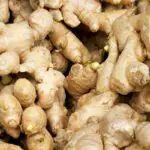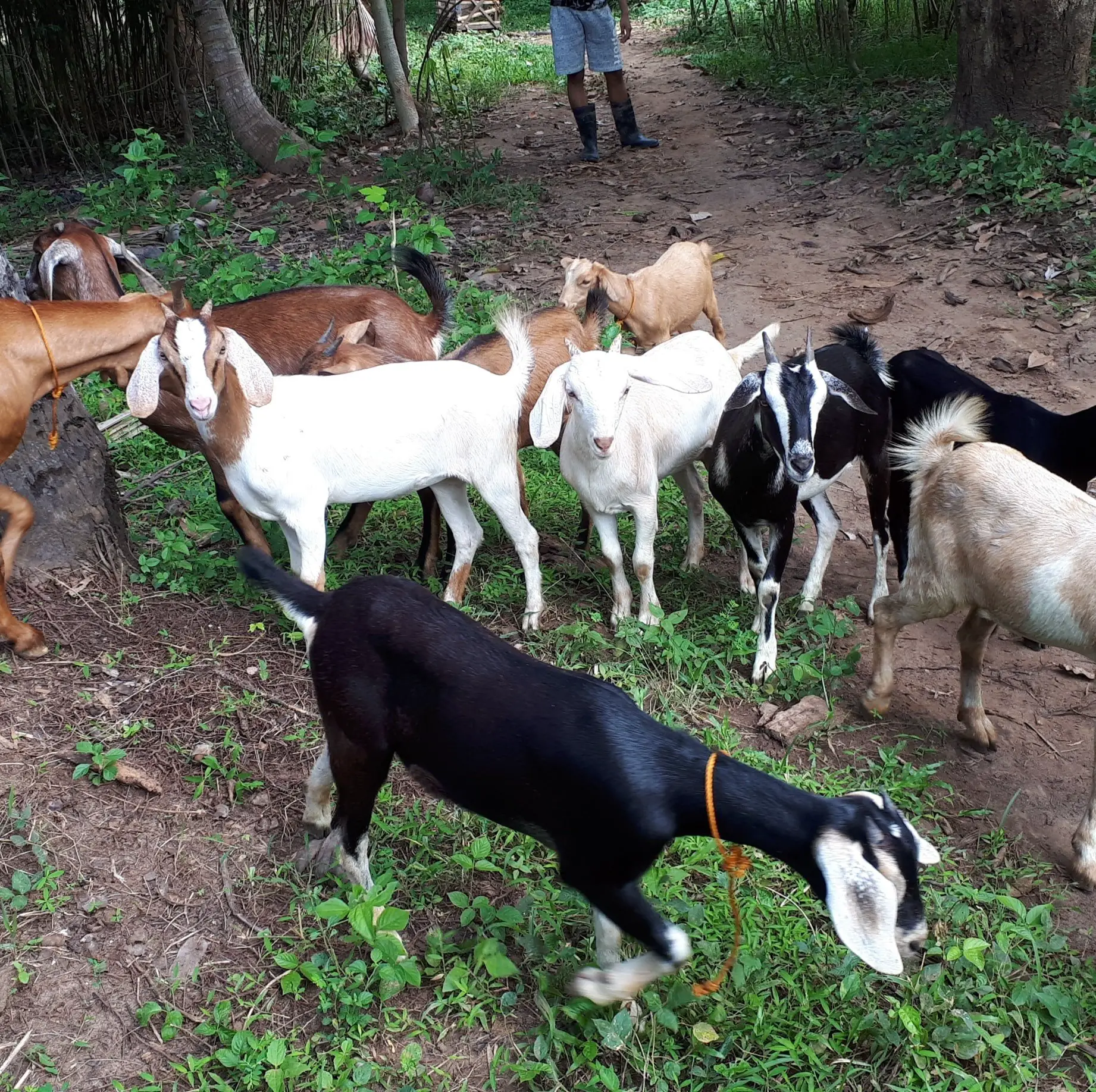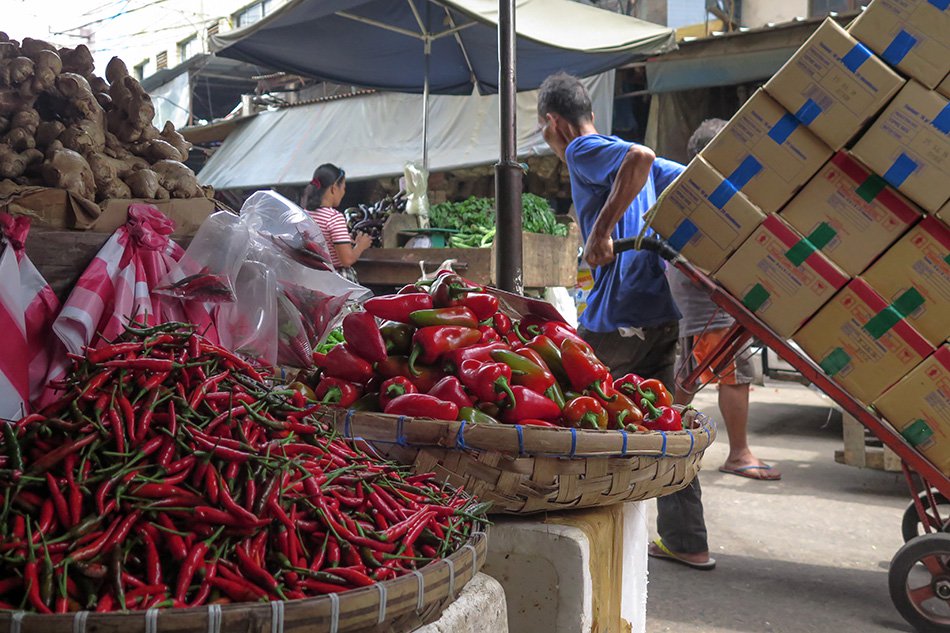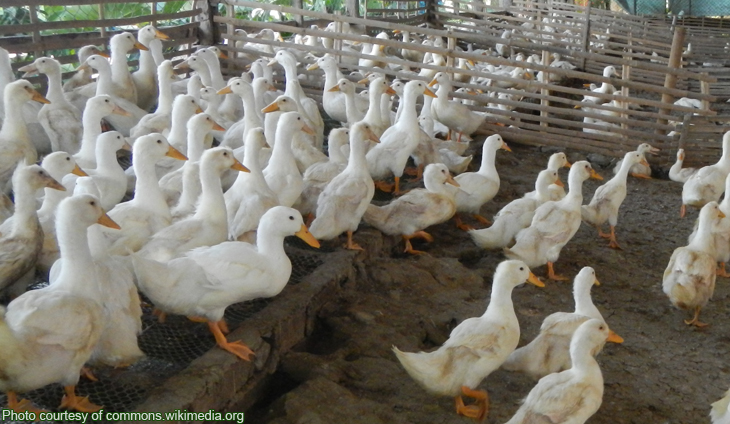In the context of a pandemic that restricted the movement of people, goat raising, just like any other backyard cottage industries may be the way to go for folks wondering how to cultivate available land in the neighborhood.
Table of Contents
Why Invest in Goat Raising
Unlike its livestock peers, raising goats is better suited to a typical Filipino community setting. They require less investment, they multiply faster and fit a limited area not suited to raising cows or deal with diseases normally associated with pigs.
While supply chains may face constraints due to restrictions, goat production can serve the needs of nearby communities for meat requirements for daily consumption or parties as well as occasions of cultural importance such as fiestas and big family gatherings. Also, goat milk provides a dairy alternative for people who suffer certain allergies such as cow milk allergies and gastrointestinal disorders.
Goats are very popular among Filipinos because they require low initial capital investment, fit the smallholder farm conditions, and multiply fast. Culturally, goats are integral to every special occasion such as birthdays, baptisms, weddings, and fiestas. Hence, they command a higher price compared with other meats in the market.
Goats require low maintenance because they eat tree leaves, weeds, grasses, and agricultural by-products. They are not only a source of proteins for Filipinos but they also provide much-needed income. In fact, goats provide a livelihood to about 15 million Filipinos across the country.
As goat production requires low initial investment and low risk compared to other livestock species, it is thus an attractive undertaking among resource-poor families. Women and children can raise the species, making it a sound option to augment other government programs on livelihood.
| 25-doe level | 50-doe level | 100-doe level | |
| Total expenses for 5 years (P) | P373,262 | P762,002 | P1,524,004 |
| Total income for 5 years (sale of stocks + stocks inventory value (P)) | P623,750 | P1,219,500 | P2,439,000 |
| Net income for 5 years (P) | 250,489 | 457,498 | 914,996 |
| ROI (%) | 67 | 60 | 60 |
Sample projected income statement based on number of does
| BUSINESS | INVESTMENT | PRODUCT | MARKET |
| Sale of Breeders | Pure or upgraded Nubian, Toggenburg or Boer buck (P7,500-P12,500 per head) + Native or upgraded does (P1,500 – P4,000 per head) |
Pure or upgraded breeders for sale (P3,000 – P12,500 per head) | Private farms and government institutions. |
| Sale of goat meat or live slaughter goats | 1 upgraded Boer for every 25 females + 100 does for every 1 slaughter goat for sale per day; 200 does for every 2 goats for sale per day |
Live animal for sale (P120 – P180 per kg or minimum of 4,500 per head per day) Processed meats like “tapa”, “tocino” or “satey kambing” |
Meat vendors in the wet market Kambingan restaurants, hotels, supermarkets |
| Buck for hire | Pure or upgraded buck | Buck service (P50 – P150 per service | Goat raisers in the village. |
| Sale of products from goat’s milk | Pure or upgraded goats of the Anglo Nubian (AN) or Saanen breed. Tools and equipment for pasteurization of milk |
Goat milk (.7 – 2 kg in 215-250 days of milking) Yogurt, cheese, soap, or lotion |
A market where fresh milk is sold Cosmetic manufacturing companies |
Types of goat raising businesses and corresponding products and markets.
But before you enter into such an enterprise you must ask yourself one important question: will running dairy goats suit your lifestyle?
Challenges of Goat Raising
Although goats are very rewarding animals to work with, looking after them can be a challenging task.
- Limited feed resource. Heavy land utilization that causes depleting feed sources reduces available grazing land for goats.
- Climatic variations. This includes low water supply during the dry season, flood or lightning strike can pose hazards to goats.
- High kid mortality rate. This can be due to colibacillosis, starvation, extreme climatic condition, death of the mother due to parasitic infestation.
- Lack of available vet services. Adequate vet services are not available in some areas so goats don’t get proper treatment once they become sick or ill.
- Inadequate knowledge. Farmers may have a limited understanding of scientific feeding practices and feeding management especially if technical assistance is inaccessible.
- Predator problems. Feral pigs or wild dogs can target goats if their regular food supply is disrupted.
- Risk of crop damage. Goats thrive when allowed to roam freely, but they can also cause damage when they munch carrots, celery, squash, and other fruits and vegetables.
- Theft. Goats can be easily stolen given their relatively smaller size compared to their livestock cousins.
Goat Feed Requirements
Food and hydration are essential not only for goat survival but also for good milk production and healthy offspring. When determining feed rations, those rich in energy and protein are the most important elements to consider.
Lack of energy sources from feeds is the most common problem affecting production and protein is essential for growth, pregnancy, and milk production. Feed analysis can be a valuable tool in determining what nutrients your feed may lack.
In the context of Philippine goat production, feeds are abundant during the wet season but can be in scarce supply during the dry season, exacerbated by the effects of climate change. But researchers from the Central Luzon State University are developing pellet feeds that contain ingredients such as ipil-ipil, kakawate, and rensonii; concentrates; and mineral supplements that supply the energy and protein needs of the goat herd.
Pelletized feeds provide better feed nutrition value that leads to a faster growth rate, efficiency in the feeding process for animal raisers as pellets can be stored at room temperature and require less storage space.
Feed budgeting should be carried out throughout the year and take into account pasture supply and other sources of feed if needed. Also, regular blood and tissue testing of goats is essential to ensure that copper), selenium, and cobalt levels are adequate and that levels of copper and selenium, which are toxic, do not overdose.
A month before mating, the doe should be gaining weight so that they are in good condition during mating and to help them meet the extra demands of the fetus and milk production.
A goat fed with poor feed quality can be susceptible to hypocalcaemia (milk fever – low levels of calcium in the blood) or pregnancy toxaemia (sleepy sickness – glucose deficiency).
Common breeds of goats in the Philippines
The most common goat breeds in the Philippines are:
- Native – This breed is small, stocky, and low-set. Colors range from red, white or black, or a combination of these colors. Milk production is just enough for its kids. It weighs 20 to 30 kilograms at a mature age.
- Anglo Nubians – Its distinguishing features include drooping and pendulous ears, and brown hair or a combination of brown and black color. It usually weighs 70-90 kilograms at a mature age and produces 1-2 liters of milk daily.
- Boer – This is a meat-type breed with distinct white body color and usually black or reddish-brown from rear legs to the head. The goat weighs an average of 90 kilograms at a mature age.
- Saanen – This breed originated from Switzerland, and is characterized by pure white to off-white in color. It holds the distinction as the highest milk producer at 1.8 liters daily and an average adult weight of 70 kilograms.
- Toggenburg – This breed has distinct white markings on the face, legs, and tail and erect ears like the Saanen. Milk production averages 1.5 liters daily, and also originated from Switzerland.
- Alpine – It is of European breed has a color that ranges from off-white to red, to black. An alert breed of medium to large size, it weighs 70 kilograms at a mature age. It posses upright ears and a straight face, the breed produces 1.5 liters of milk daily.
How to select does (a female goat) to raise
- Female goats (does) should be purchased from a locality or area with similar climatic conditions so they can adapt to surroundings better.
- Although notably smaller than other breeds, native or graded does should weigh more than 25 kilograms.
- Goat udder, or the organ formed of the mammary glands of does, should be palpated for size, detection of lumps, and other abnormalities.
- Teats should be uniform at length and large enough for easy milking.
- Each individual doe must have a good appetite, possessing alert eyes, and have well-formed pupils.
How to select bucks (a male goat) to raise
- One-year-old breeder or buck that has successfully mated once is desirable.
- The acquired buck should be accompanied by pedigree records.
- Bucks must have a good producing line based on-farm records.
- Buck must come from a doe with a high twinning rate.
- Buck must be active and ready to breed in-heat doe.
- Replace buck, preferably, every three years.
How to manage and care for goats
Housing
Housing provisions for goats are necessary regardless of confined or range feeding. A goat house or shed must be built to provide shelter. Goats are averse to rain and wetness as these make them susceptible to pneumonia. They also prefer sleeping in elevated platforms like a stair-type arrangement. It must be well ventilated and drained, and easy to clean.
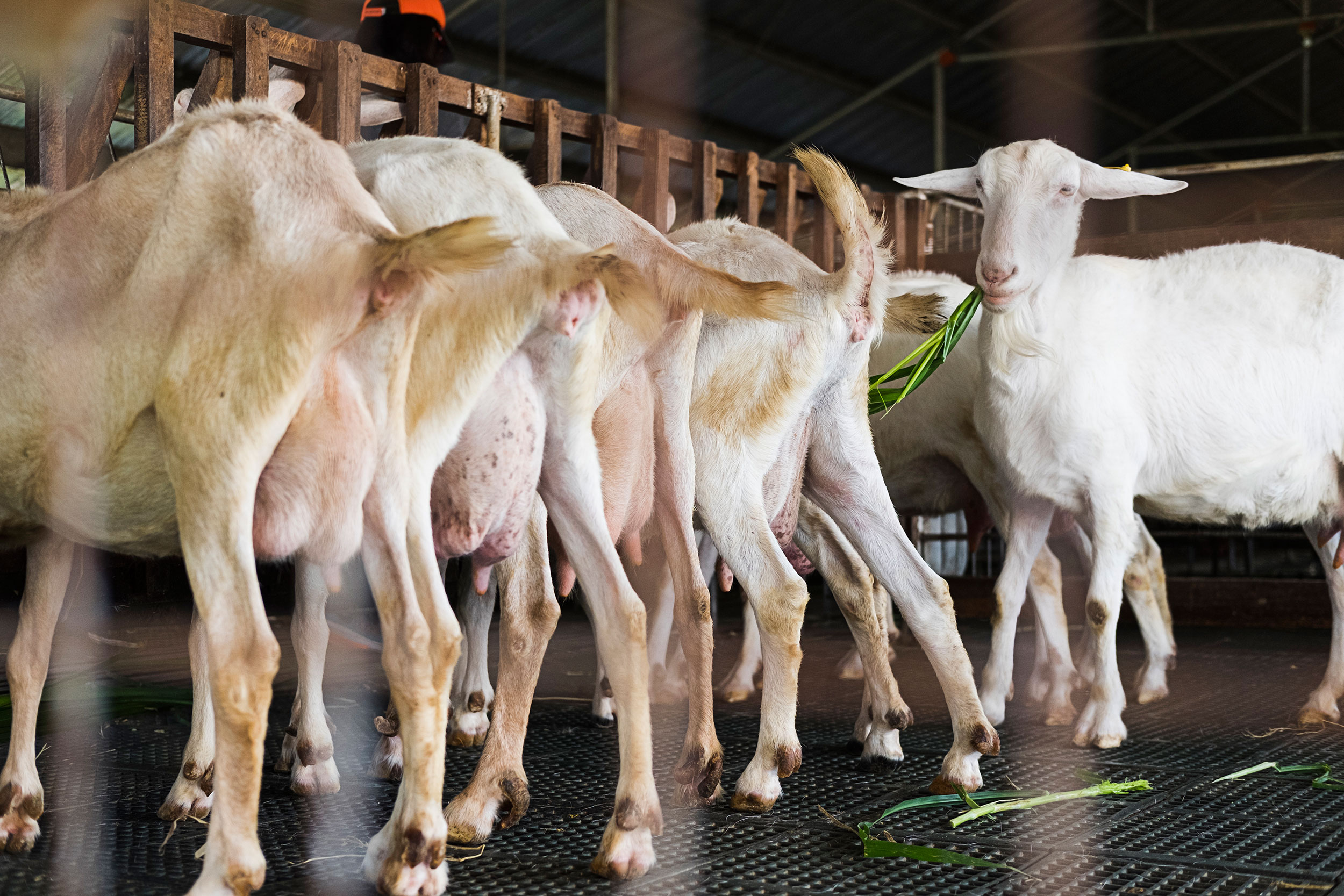
Feeding racks (silage, water, mineral, and concentrate) should be accessible to both animals and caretakers, preferably in the front of the aisle. Flooring should be provided and elevated at least 15 degrees to facilitate cleaning and drainage. Separate pens should be provided for lactating and dry does, kids, growers, and bucks. The buck pen should be visible to breeding does yet far enough to avoid transfer of the typical goat smell especially to lactating does when milk is to be sold.
A fenced loafing area beside the goat house must be provided, complete with feeding racks and water troughs, to allow animals to loaf freely. The flooring of the area must be cemented to facilitate drying. Cogon and nipa as roof materials are preferred in hot and humid areas. Ventilation is of utmost importance.
The majority of pneumonia cases can be traced to excessively warm and humid interiors and sudden changes in temperature. Allow a 0.5 to 1 ft clearance between floor to wall and wall to beam to create an adequate circulation and to lower draft. It is desirable to maintain an interior temperature of 28 to 30°C. It has been established that above 30°C ruminants are inhibited from eating.
Lighting may also be provided in the barns during the night. Goats consume up to 30% of the day’s intake during the night when light is provided.
Fencing Guide for Goats
Nine-eye hog wire is the cheapest and most effective fencing available in the Philippines. Posts must be staked every 2 meters. Goats are fond of pounding their feet and scraping their bodies on the fences so it must be sturdily built. Barbwire fencing requires a minimum of four strands so it becomes more costly besides making goats prone to wounds.
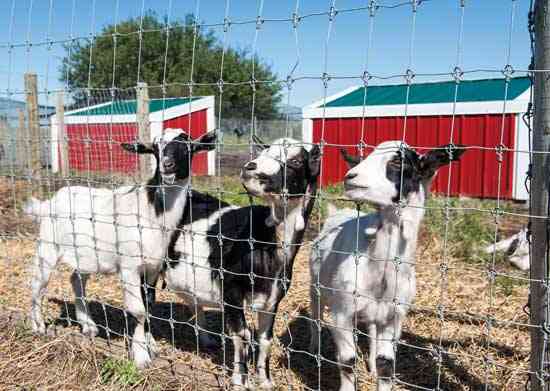
Pasturing
A well-developed/improved pasture can carry up to 15 heads per hectare. When a combined grazing confinement method is observed, provision of a developed 3 hectares per 50 goat heads. Pasture divided into 9 paddocks will be desirable. Separate pasture paddocks should be provided for the dry doe, buck kids, and growers. Pasturing during the cool times of the day is commonly due.
Care of Dry and Pregnant Doe
If the doe is being milked, dry (stop milking) at least 1 Y2 to 2 months before the kidding date. This will give her enough reserve for the next lactation. Put all dry does in one compartment. One week before kidding, place her in a separate kidding pen. This can be predicted by swelling and discharge from the vulva, engorgement, and waxing of the teats, and constant lying down of the doe.
Avoid any form of noise in the kidding area. Sometimes it is necessary to help the pregnant doe during the kidding, especially to native does breed with pure bucks because the kids are bigger. Dystocia, or difficult delivery, is common in these cases. Be sure that the presentation is right before attempting to pull out the kid. In the anterior presentation, both front legs and head are presented and in posterior presentation, both hind limbs come out at the same time.
Over-sized kids should be pulled out with even, continuous pressure. In difficult cases, it is best to see a practicing veterinarian.
Care of the Lactating Doe and Newborn Kids
Immediately after delivery, wipe the kid’s mouth, nose, and body with a clean, dry cloth and massage the thoracic area to initiate breathing.
Normally, the mother does this, but sometimes the mother is too weak to do it. Be sure no mucus is clogging the airways. The kids must be able to suck within one hour. For very weak kids, feeding colostrum through a stomach tube usually produces dramatic results.
A first-time mother sometimes is reluctant to suckle the young due to udder pain caused by over engorgement of milk. Restraining the doe for the first suckling will usually relieve udder pain. If colostrum in the udder is not fully consumed by the kid, stripping (manually milking out excess) will be necessary to prevent mastitis. The placenta must come out within 24 hours from the expulsion of the fetus.
Tie the umbilical cord with a sterile string and apply disinfectant. Allow the kids to suckle for the first 4 to. S days. If the doe is to be milked, separate the kids from the mother and start feeding using a baby bottle (8 oz. Size), (refer to feeding guide for dosage).
If the doe is not to be milked, the doe can be taken out of the pen for feeding and returned to the kid three times a day and the whole night. This method will ensure greater livability to the kid by not exposing it to the elements and proper feeding of the doe. Does wean early (4 to 5 days) usually return to heat after 1 to 2 months?
When the doe comes into heat, introduce it to the buck, not vice-versa. Two services a day for two days is an optimum. If the doe does not conceive, heat may return in 8 to 12 days. Higher conception is accomplished in the secondary heat. If breeding is successful, milk production drops after one month and the right side of the abdomen starts to fill up.
How to Practice Efficient Goat Milking
Goats are generally docile animals, which makes milking them relatively easy. However, milking periods must be established and strictly adhered to. If milking is done twice a day, e.g. 6 AM and 6 PM, the process should not be delayed or advanced. Possibly, the same person should be used. Goats can withhold milk, so unnecessary changes in the routine should be avoided.
- Milk quickly and continuously
Milk let down can be initiated by washing the udder with lukewarm water and wiping with a clean towel. All milking utensils, especially the milkers’ hands, must be thoroughly cleaned.
- Feed concentrates during milking
This serves as an incentive to the goats for them to enjoy and look forward to. Contrary to popular belief, properly drawn and processed goat milk have no offending smell. During milking, the buck should not be near the doe to avoid the transfer of the typical goat smell to the milk.
Care of Weanling and Growing Kids
Place all weaned kids in a separate pan, and if possible, according to size. If male kids are to be raised for meat, castrate as early as possible, preferably within the first month. If females are to be raised for milking, check for excess teats and have them removed. Horn buds usually appear within the first to the third month. De-horn when buds reach the size of a fingernail. Separate males from females at the age of four months. Goats sometimes reach puberty at this age.
Start breeding females at 8 to 10 months. Bucks can start breeding at the same age.
Care of the Breeding Buck
The breeding buck must always be confined separately but always visible to the does. The buck is the source of the typical goat smell such that direct contact with the doe must be avoided. Provide a loafing area. One to two-year-old buck can make 25 to 50 doe services a year, an older buck more.
Best Goat Raising Practices
Does reach puberty from 4 to 18 months. The best breeding age will be 10 to 12 months, depending on desired weight. Limit yearling buck services to 25 doe services/year. Older bucks can cover up to 75 per year. Buck to doe ratio is 1:25.
Signs of Heat or Estrus:
1. Mucus discharge from the vulva, causing matting of tail hair.
2. Uneasiness, constant urination, lack of appetite, and bleating.
3. Seeks out or stays near the buck and lets herself be mounted.
When breeding, always introduce the doe to the buck, not to the doe herd. Particularly when bucks have not been used for a long time, it will be dangerous to mix it with a herd of pregnant does for they will likely breed indiscriminately. Two to four breedings during the heat period will suffice.
It is highly impractical if not economical to raise pure breed goats unless the main purpose is to sell breeders. The preferred method will be to upgrade local native or grade does with pure bucks. Crossbreeds usually perform better than pure ones under local conditions. Infusion of two or more bloodlines into the native doe will elicit a better product due to hybrid vigor.
Three-way crosses between the native, any of three Occidental breeds, and the Nubian has produced
a greatly superior animal than any of the three under our conditions. Higher milk production should be the main consideration for it will not only mean bigger kids but also more milk for human consumption.
A maximum infusion of75% foreign bloodline must be observed to retain the natural resistance of the native. Never practice inbreeding unless fully knowledgeable in breeding techniques. On the other hand, intensive culling, especially in milking herds, will largely be beneficial.
Dystocia is very common in crossing natives with large pure breeds due to the invariably large size of the unborn kids. Crossbreed birth weights of up to four kilos for multiple births and up to six kilos for single births have been observed while native birth weights reach only 2 and 4 kilos for multiple and single births, respectively.
Thus, in crossbreeding, large native does with a minimum weight of 25 kilos or more and those that have given birth at least once should be used. Providing human assistance during birth will also be of help in saving kids, but this should be done only when necessary.
Anestrus, or failure to come in heat, is a common problem most particularly with high-producing does. Vitamin, mineral, and other nutrient deficiencies, infections of the genital tract, and hormone deficiencies are some of the various causes. Several hormones, like prostaglandin, progesterone sponges and implants, and pregnant mare serum (PMS) have been used with varying rates of success.
Routine administration of oxytocin right after kidding and before weaning (5 days) aids in faster expulsion of the placenta, uterine fluids, and rapid regression of the uterus. Routine Vitamin A, D & E injections to breeding herds also contribute to reproductive well-being.
Fifty percent of breeding problems can be traced to the buck used. Routine check-up of the bucks’ health condition, especially of the genito-urinary tract, should be done. Preputial scraping, blood tests and, sperm motility tests are some very useful procedures to follow in, successful buck management. Always consult a trained veterinarian to do these tests.
Other Goat Raising Management Best Practices
1. HoofTrimming – Goats’ hooves under confinement are usually overgrown. Trimming is then required. A rose pruner and a small curved knife are adequate tools. Cut excess hoof until level with the frog (white-centerpart). Untrimmed hooves will cause lameness and make it prone to footrot. Bucks refuse to mount when having sore feet.
2. Dehorning – Especially in milking herds, dehorning is essential. A dehorned animal is more docile than a horned one. It will also eliminate unnecessary wounds due to fighting. Dehorn when horn buds appear (2 to 4 mos.) using hot iron cautery. A Y2 inch GI pipe is an effective and cheap material for cauterizing. Chemical cautery is not preferred because kids tend to lick one another and may therefore lead to cauterized or burned tongues.
3. Castration – Castration of unwanted male goats is preferable within the first month of age. The testicles at this age are still not developed. thus there is lesser bleeding and stress. Castrated males grow faster than uncastrated males and are free of the goaty male odor.
4. Tattooing, Ear Notching, and Other Forms of Identification – In order to keep track of individual animals, positive identification is needed. No recording is possible without this. Ear notching is done more commonly because of permanence and easy identification. Refrain from using plastic bags. Tattooing causes no deformities but requires special tools that may be costly.
5. Recording – For a good breeding herd program, a proper and well-kept recording system is necessary. The record reflects all the essential data of individual animals.
If you wish to pursue a training course on goat production, the Agricultural Training Institute of the Department of Agriculture offers training for farmers and goat raisers.
For further details about this activity, kindly contact:
Florita G. Lozada
Project Officer
0930-8208661
Or download a PDF copy of the goat raising guide from the Department of Trade and Industry




